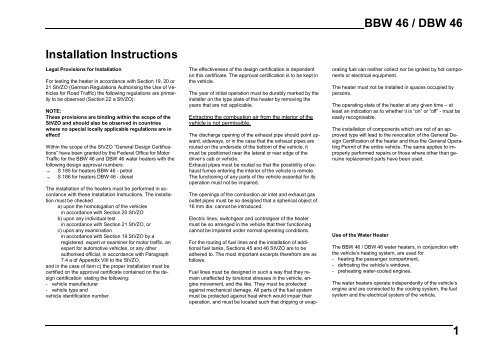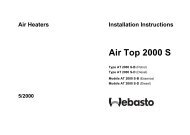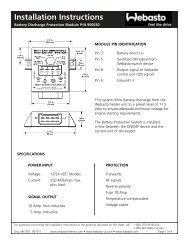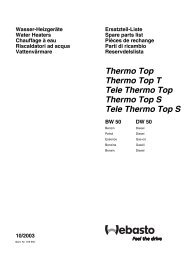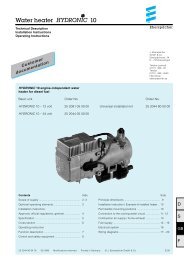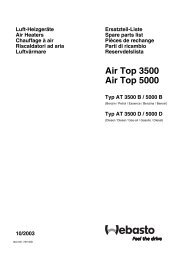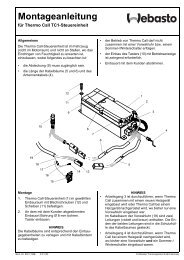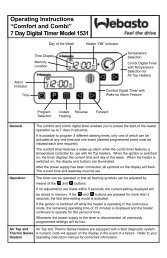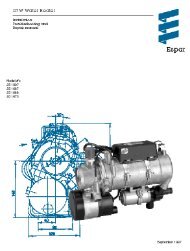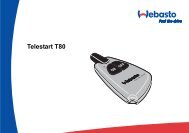BBW - DBW 46 - VW-Bus-T4.de
BBW - DBW 46 - VW-Bus-T4.de
BBW - DBW 46 - VW-Bus-T4.de
You also want an ePaper? Increase the reach of your titles
YUMPU automatically turns print PDFs into web optimized ePapers that Google loves.
<strong>BBW</strong> <strong>46</strong> / <strong>DBW</strong> <strong>46</strong><br />
Installation Instructions<br />
Legal Provisions for Installation<br />
For testing the heater in accordance with Section 19, 20 or<br />
21 StVZO (German Regulations Authorising the Use of Vehicles<br />
for Road Traffic) the following regulations are primarily<br />
to be observed (Section 22 a StVZO):<br />
NOTE:<br />
These provisions are binding within the scope of the<br />
StVZO and should also be observed in countries<br />
where no special locally applicable regulations are in<br />
effect!<br />
Within the scope of the StVZO ”General Design Certifications”<br />
have been granted by the Federal Office for Motor<br />
Traffic for the <strong>BBW</strong> <strong>46</strong> and <strong>DBW</strong> <strong>46</strong> water heaters with the<br />
following design approval numbers:<br />
~ S 185 for heaters <strong>BBW</strong> <strong>46</strong> - petrol<br />
~ S 186 for heaters <strong>DBW</strong> <strong>46</strong> - diesel<br />
The installation of the heaters must be performed in accordance<br />
with these Installation Instructions. The installation<br />
must be checked<br />
a) upon the homologation of the vehicles<br />
in accordance with Section 20 StVZO<br />
b) upon any individual test<br />
in accordance with Section 21 StVZO, or<br />
c) upon any examination<br />
in accordance with Section 19 StVZO by a<br />
registered expert or examiner for motor traffic, an<br />
expert for automotive vehicles, or any other<br />
authorised official, in accordance with Paragraph<br />
7.4 a of Appendix VIII to the StVZO,<br />
and in the case of item c) the proper installation must be<br />
certified on the approval certificate contained on the design<br />
certification stating the following:<br />
- vehicle manufacturer<br />
- vehicle type and<br />
vehicle identification number.<br />
The effectiveness of the design certification is dependent<br />
on this certificate. The approval certification is to be kept in<br />
the vehicle.<br />
The year of initial operation must be durably marked by the<br />
installer on the type plate of the heater by removing the<br />
years that are not applicable.<br />
Extracting the combustion air from the interior of the<br />
vehicle is not permissible.<br />
The discharge opening of the exhaust pipe should point upward,<br />
sideways, or in the case that the exhaust pipes are<br />
routed on the underside of the bottom of the vehicle, it<br />
must be positioned near the lateral or rear edge of the<br />
driver’s cab or vehicle.<br />
Exhaust pipes must be routed so that the possibility of exhaust<br />
fumes entering the interior of the vehicle is remote.<br />
The functioning of any parts of the vehicle essential for its<br />
operation must not be impaired.<br />
The openings of the combustion air inlet and exhaust gas<br />
outlet pipes must be so designed that a spherical object of<br />
16 mm dia. cannot be introduced.<br />
Electric lines, switchgear and controlgear of the heater<br />
must be so arranged in the vehicle that their functioning<br />
cannot be impaired under normal operating conditions.<br />
For the routing of fuel lines and the installation of additional<br />
fuel tanks, Sections 45 and <strong>46</strong> StVZO are to be<br />
adhered to. The most important excerpts therefrom are as<br />
follows:<br />
Fuel lines must be designed in such a way that they remain<br />
unaffected by torsional stresses in the vehicle, engine<br />
movement, and the like. They must be protected<br />
against mechanical damage. All parts of the fuel system<br />
must be protected against heat which would impair their<br />
operation, and must be located such that dripping or evaporating<br />
fuel can neither collect nor be ignited by hot components<br />
or electrical equipment.<br />
The heater must not be installed in spaces occupied by<br />
persons.<br />
The operating state of the heater at any given time – at<br />
least an indication as to whether it is “on” or “off” - must be<br />
easily recognisable.<br />
The installation of components which are not of an approved<br />
type will lead to the revocation of the General Design<br />
Certification of the heater and thus the General Operating<br />
Permit of the entire vehicle. The same applies to improperly<br />
performed repairs or those where other than genuine<br />
replacement parts have been used.<br />
Use of the Water Heater<br />
The <strong>BBW</strong> <strong>46</strong> / <strong>DBW</strong> <strong>46</strong> water heaters, in conjunction with<br />
the vehicle’s heating system, are used for<br />
- heating the passenger compartment,<br />
- defrosting the vehicle’s windows,<br />
- preheating water-cooled engines.<br />
The water heaters operate independently of the vehicle’s<br />
engine and are connected to the cooling system, the fuel<br />
system and the electrical system of the vehicle.<br />
1


